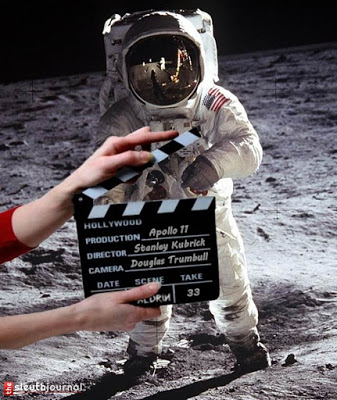
The men and women who have labored to set forth the truth of the Apollo Space Program, revealing it to be a deception on a grand scale, have provided abundant proofs exposing the lies of NASA. Because the majority of material presented to the public by NASA consisted of videos and still images, an examination of these elements has taken center stage as the main exhibits presented to the public jury to establish the fact that a hoax has taken place. Even with NASA claiming to have lost a vast amount of the highest quality original video and still images of the moon landings, the evidence of fakery is both abundant and compelling.
Photographic technology in the late 1960s and early 1970s was not what it is today. There were no digital cameras. Auto-focus had not been invented for it requires miniaturized computer circuitry. IBM’s Personal Computer would not come out for another decade, being first released in 1981. Even then, the first PC was underwhelming in its capabilities. The entire computer processing capacity of NASA’s Apollo Space Program was less than that of an Apple iPhone, even the first generation Apple iPhone. Indeed, the memory and processing capacity of the iPhone dwarfs the abilities of the mainframe computers NASA was using for the Apollo Program.
The IBM System/360 Model 75 was the workhorse of NASA. Its maximum memory capacity was 1 Megabyte. For comparison, I am typing this book on a 2 year old laptop computer that has 24 Gigabytes of RAM memory, and 1 Terabyte of solid state hard drive storage. Mega is a prefix for a million, Giga a prefix for billion, and Tera the prefix for trillion. The IBM mainframe NASA used could perform 940 kIPS (thousand instructions per second.) For comparison, the Apple iPhone 1 operated at a speed of 412 million cycles per second. The iPhone also had an additional graphics processor giving it even more computational capability.
For additional reference to the state of technology in the Apollo years, color television sales did not surpass sales of black and white televisions until 1972, the final year of the moon program. The majority of Americans watched the moon landings on black and white cathode ray tube televisions, whose average screen size was 12″ for a tabletop model, and 22″ for a console T.V.. There is more computer capacity in a programmable toaster today than there was present in the Apollo command and lunar modules’ navigational computers.
There is an entire generation today which cannot relate to the technology of the 1960s and 1970s. Everyone back then grew up without home computers, without the Internet, and the only telephones they had were landlines. If you weren’t home, no one could contact you. Ahhh!!! Those were the days! Video games would not become popular for another decade, so children actually played outside with friends when they got out of school in the afternoon. It was a very different world.
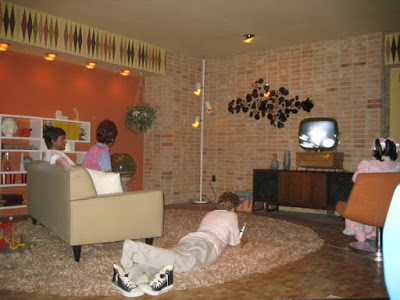
American Family Watching Moon Landing in 1969
The state of the art for film cameras was rudimentary when compared to cameras with computer circuitry in them today.
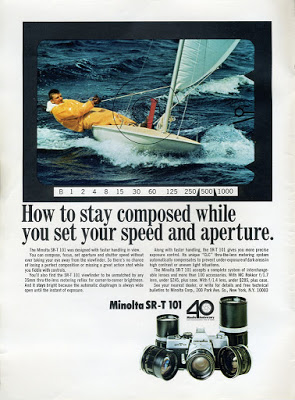
All cameras during this period used film. The ad above reveals the challenges of taking a good photo. The photographer had to keep the subject framed while adjusting the shutter speed and aperture (the size of the hole which allows light into the camera). The typical camera of that era had a viewfinder which the photographer would look through. The photographer would have to center the image to be shot in the viewfinder. They would also have to adjust aperture and shutter speed using various dials mounted on the camera. Additionally, they would turn a focus ring to make sure the item to be photographed was clear and sharp. If any of these settings were incorrectly chosen, the photograph would suffer degradation and likely end up unusable.
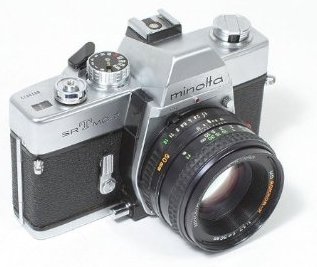
Minolta SR-T
Imagine attempting to take photographs using a camera like this while you were blindfolded and wearing bulky, non-tactile gloves over both hands. This is essentially the challenge presented to the astronauts of the Apollo missions. The cameras used in the Apollo missions were hard mounted to the chest area of the astronaut’s space suit. The camera did not swivel. It had to be aimed by the astronaut turning his body. Additionally, the cameras had no view finders, so the astronaut could only guess where the camera was pointed. It would have been useless for the camera to have a viewfinder for, due to the restrictions of the space suit, the astronaut could see only a small portion of the camera mounted to his chest.
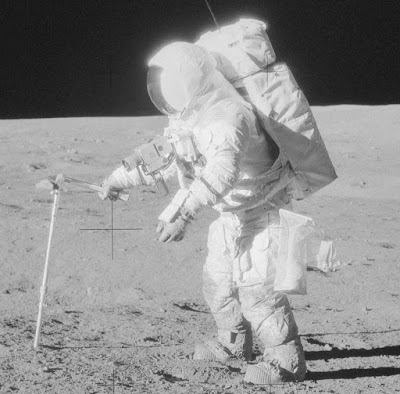
Apollo 11 Astronaut with Camera
These liabilities have led numerous people to question how the astronauts could have captured some of the iconic images on the surface of the moon which have become so popular. These images appear to be expertly composed with the subject perfectly framed, everything sharply in focus and the exposure settings adjusted precisely for the lighting conditions on the moon. Since no one had ever set foot on the moon before, and the lighting conditions on the moon were unknown, such precision is hard to explain.
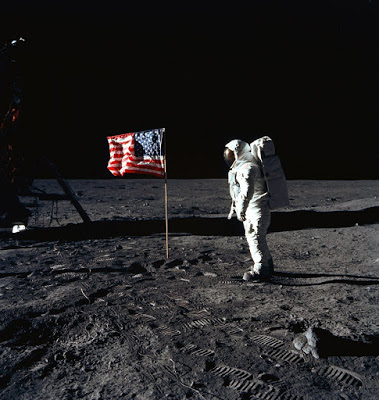
Apollo 11 – Buzz Aldrin and Flag
The image above is one of the most iconic shots from the Apollo space program. It has not been cropped by NASA. There is a 5 x 5 grid of crosshairs, or reticles, on the image which shows that it was centered perfectly. The lighting conditions would be challenging, to say the least, yet the image is perfectly exposed. The eye is drawn to the brilliantly lit flag which is sharply in focus, and then to the astronaut who is illuminated.
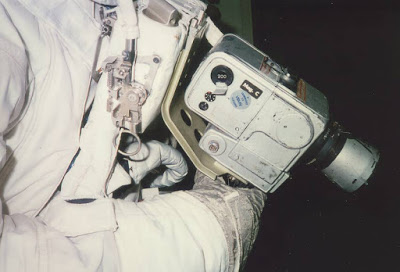
Pretty Good Shot, Neil!
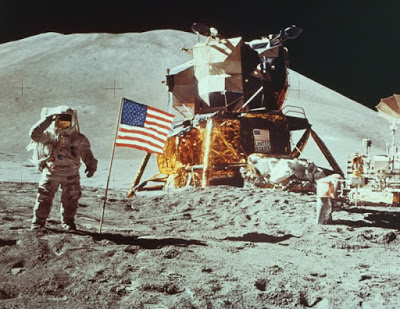
The image above is from a later mission when the astronauts took a lunar rover with them. It is a remarkably composed image, exhibiting professional aptitude. The eye is guided from the astronaut to the flag then to the lunar module where the image of the flag and words “United States” stand out from the shadowed surface, and finally to the lunar rover. It would be a remarkable shot for a professional to take, but for an astronaut handicapped with no view finder, inside a bulky space suit, unable to see precisely where the camera was pointing, and having to guess the proper exposure settings in very challenging lighting conditions, it is a tremendous feat. Never mind that the mountains in the background and the ground behind the lunar module are different colors and texture than the foreground soil, suggesting that a backdrop was used, the image served as a masterful piece of propaganda.
There are other difficulties with the photo narrative provided by NASA. Hasselblad was selected to supply the cameras for the lunar program. Jan Lundberg, the project engineer at Hasselblad, has affirmed that no special adaptations were made to the cameras to block radiation or to make the camera suitable for the temperature extremes which would have been encountered on the moon. There was no lead lining to protect the film from exposure to the radiation which would have been present on the moon. Nor was the Kodak film used by the astronauts stored in lead lined containers before, or after use, not even when passing through the Van Allen Radiation Belts.
I remember back in the 1970s and later being informed that cameras and film should be removed from travelers’ luggage when passing through the x-ray machines at the airport. The x-rays could pass through the camera body and expose the film. On Kodak’s website, the following information is posted.
Suggestions for Avoiding Fogged Film
X-ray equipment used to inspect carry-on baggage uses a very low level of x-radiation that will not cause noticeable damage to most films. However, baggage that is checked (loaded on the planes as cargo) often goes through equipment with higher energy X rays. Therefore, take these precautions when traveling with unprocessed film:
• Don’t place single-use cameras or unprocessed film in any luggage or baggage that will be checked. This includes cameras that still have film in them.
• If an attendant or security personnel informs you that your carry-on baggage must be stowed with the checked luggage or go through a second scan, remove your unprocessed film.
• Have your exposed film processed locally before passing through airport security on your return trip.
• If you’re going to be traveling through multiple X-ray examinations (more than 5 times), request a hand search of your carry-on baggage. FAA regulations in the U.S. allow for a hand search of photographic film and equipment if requested. (See below for further FAA information.) However, non-US airports may not honor this request.
• Request a hand inspection for all motion imaging origination films. Testing shows fog on motion imaging films even after a single X-ray scan…
• If you’re asked to step aside for a more thorough scan of your carry-on baggage, the film could be harmed if they use the more intense X-ray equipment.You should take your unprocessed film out of your luggage.
• Lead-lined bags, available from photo retailers, will weaken the X-radiation on film and reduce potential harm. However, the effectiveness of any particular lead bag depends on the intensity and electric potential of the X-ray generator, the lead’s thickness, and the film speed.
[Source: https://www.kodak.com/global/en/service/tib/tib5201.shtml]
The typical Apollo moon mission lasted from 8-12 days. During this time, all film would have been subjected to levels of radiation that far exceed that of an x-ray machine. During the years 1969-1970, the Sun was going through a solar maximum when solar radiation is at its peak. Even after one passes through the Van Allen Radiation Belts where radiation levels can exceed 100 roentgens per hour, cosmic rays and solar flares continue to bombard all objects in space. At the science.nasa.gov website, the following statement is found.
Just as meteoroids constantly bombard the Moon so do cosmic rays, and they leave their fingerprints on Moon rocks, too. “There are isotopes in Moon rocks, isotopes we don’t normally find on Earth, that were created by nuclear reactions with the highest-energy cosmic rays,” says McKay. Earth is spared from such radiation by our protective atmosphere and magnetosphere.
Even if scientists wanted to make something like a Moon rock by, say, bombarding an Earth rock with high energy atomic nuclei, they couldn’t. Earth’s most powerful particle accelerators can’t energize particles to match the most potent cosmic rays, which are themselves accelerated in supernova blastwaves and in the violent cores of galaxies.
[Source: http://science.nasa.gov/science-news/science-at-nasa/2001/ast23feb_2/]
These words are quoted from an article which is attempting to debunk some of the criticisms of those who claim the moon landings were faked. The author is speaking of how difficult it would be to fabricate a moon rock. Yet, in his explanation he provides additional ammunition for those who claim the moon landings never happened. “Oh what a tangled web we weave, when first we practice to deceive.” It is very difficult to defend lies. They always lead to additional lies.
If, as this writer states, the moon is “constantly” being bombarded by cosmic rays due to its lack of an atmosphere and magnetosphere, then surely the radiation would affect much more than the rocks on the moon. It would also affect the men who land on the moon, and their equipment, including their film. Yet, Hasselblad’s lead project engineer states that no steps were taken to build radiation shielding into their camera. The Lunar Module itself was constructed of two thin layers of aluminum, which presents almost zero protection against radiation. All of the film that went to the moon and back should have been washed out due to its exposure to x-rays and other forms of space radiation.
Another problem with the NASA account of lunar photography is that no steps were taken to protect the cameras and film from the temperature extremes on the lunar surface. NASA reports that the astronauts of Apollo 11 experienced temperature swings between 180 degrees Fahrenheit in the sun and -160 degrees Fahrenheit when in shadow.
(https://www.hq.nasa.gov/alsj/a11/A11_PAOMissionReport.html)
I think NASA was being conservative about the weather on the Moon, for other sources state that the temperature on the moon fluctuates between much greater extremes.
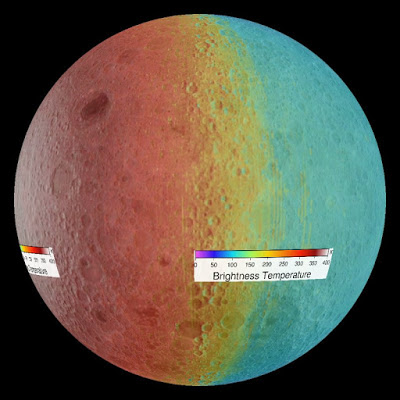
Moon Temperatures
Temperatures on the moon are extreme, ranging from boiling hot to freezing cold depending on where the sun is shining. There is no significant atmosphere on the moon, so it cannot trap heat or insulate the surface.
The moon rotates on its axis in about 27 days. Daytime on one side of the moon lasts about 13 and a half days, followed by 13 and a half [days] of darkness. When sunlight hits the moon’s surface, the temperature can reach 253 degrees F (123 C). The “dark side of the moon” can have temperatures dipping to minus 243 F (minus 153 C)…
The moon tilts on its axis about 1.54 degrees – much less than Earth’s 23.44 degrees. This means the moon does not have seasons like Earth does. However, because of the tilt, there are places at the lunar poles that never see daylight.
The Lunar Reconnaissance Orbiter measured temperatures of minus 396 F (minus 238 C) in craters at the southern pole and minus 413 F (minus 247 C) in a crater at the northern pole. That is the coldest temperature ever recorded in the solar system, colder even than Pluto. Scientists think water ice may exist in those dark craters that are in permanent shadow.
[Source: http://www.space.com/18175-moon-temperature.html]
(The data above was provided by NASA’s Lunar Reconnaisance Orbiter which was launched in 2009.)
NASA purchased KODAK Ektachrome ISO 160 Professional film for use in its moon cameras. KODAK has affirmed this was not a special formulation. It was identical to the film they sold to the public. It had no special radiation or temperature resistance.
In the book Dark Moon by Mary Bennett and David S. Percy, the authors reported on tests which were performed on this specific Kodak film as it was exposed to varying levels of ionizing radiation, as well as to the extreme temperatures film would encounter on the lunar surface. An appendix at the end of the book describes the controlled environment and careful measurements observed in these tests. David S. Percy FRSA, ARPS is an award-winning film & TV producer and pioneer in the use of leading edge audiovisual technologies. He is an associate of the Royal Photographic Society. (The authors are British, hence the British spelling of certain words.) Following is an excerpt from the appendix of Dark Moon.
Film Strip 8 contains correct exposures (1/60th sec @ f5.6) of the test chart which were then exposed to 25 rem of ionising radiation (8MeV x-rays). The film was processed in the normal (E6) manner. The images although visible are seriously damaged rendering them unusable.
Film Strip 9 contains correct exposures (1/60th sec @ f5.6) of the test chart which were then exposed to 50 rem of ionising radiation (8MeV x-rays). The film was processed in the normal (E6) manner. The images are barely visible, the x-rays having near obliterated the latent images.
Film Strip 10 contains correct exposures (1/60th sec @ f5.6) of the test chart which were then exposed to 100 rem of ionising radiation (8MeV x-rays). The film was processed in the normal (E6) manner. The images are completely obliterated by the x-rays.
Discussion
Ektrachrome ISO 160 appears to be significantly sensitive to x-rays. Above 100 rem exposure to x-rays any latent image is completely obliterated. Between 50 rem and 25 rem exposure to x-rays the remaining image is visible, but extremely faint. The estimated radiation dose required to degrade the image to the level produced by four hours exposure to the maximum temperature expected on the lunar surface (+82.2 C) is estimated from the above results to be in the order of only 5 rem.
Conclusion
Even a modest radiation dose to the film (5 rem and greater) would produce significant reduction of contrast and image density in the resulting Ektachrome ISO 160T transparencies.
Evaluation of High Temperature on Ektachrome ISO 160… Film…
Introduction
The following test was undertaken with fresh Ektachrome 160T Film.
According to NASA’s own data, the Temperature range the Hasselblad 500 EL/700 camera was subjected to whilst on the lunar surface was +180° F (+82.2° C) to -180° F (-117.8° C).
This range of temperature is well outside Kodak’s recommendation. The purpose of this investigation was to establish the behaviour of Ektachrome ISO 160 roll film when used at the high end of the temperature range…
Results
When compared to the control strip, the resulting transparencies in test strip 7 show significant ‘lightening’ apparent both on the test patches and on the unexposed areas of the film between and to the side of each exposed image.
Conclusion
Extended exposure to the higher end of NASA’s anticipated temperature range on the lunar surface may be expected to significantly decrease the image density of the resulting Ektachrome ISO 160 transparencies.
[Dark Moon, Mary Bennett and David S. Percy]
To summarize, the conditions in space and on the moon are not merely a threat to human life, the harsh and inhospitable environment also presents obstacles to the normal functioning of technology that was developed for use on Earth. It is very likely that all of the film used in the still and video cameras NASA purportedly sent to the moon would have been so degraded due to exposure to radiation and temperature extremes as to render all images unusable. Those charged with creating the deception of man flying to the moon and back never intended to solve all of the extraordinary challenges of such a venture. They simply wanted to create a convincing illusion while trusting that the majority of people would not take a hard look at the details.
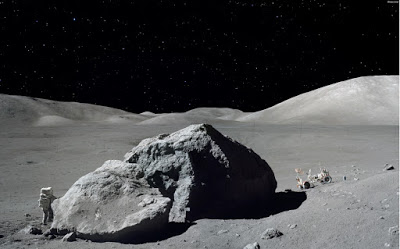
(Click on Image to View Larger and Observe the Stars in the Sky)
The image above was stitched together from two photos taken by astronaut Eugence A. Cernan during the Apollo 17 mission in 1972. The mosaic shows astronaut Harrison H. Schmitt standing next to “Tracy’s Rock,” a huge, split lunar boulder at the Taurus-Littrow landing site. The Lunar Roving Vehicle, which transported Schmitt and Eugene A. Cernan to this extravehicular station from their Lunar Module, is seen in the background. The photos were shot with the Hasselblad camera common to all of the lunar missions. The two images used to create this mosaic can be viewed at the Apollo Archive Gallery website.
http://www.apolloarchive.com/apollo_gallery.html
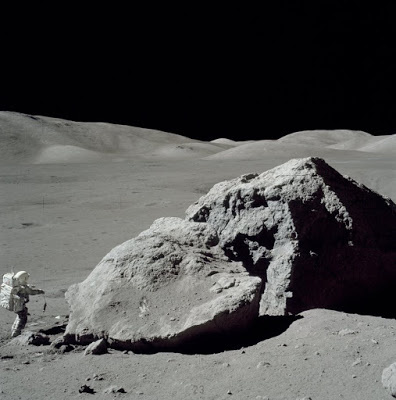
Image AS17-140-21496
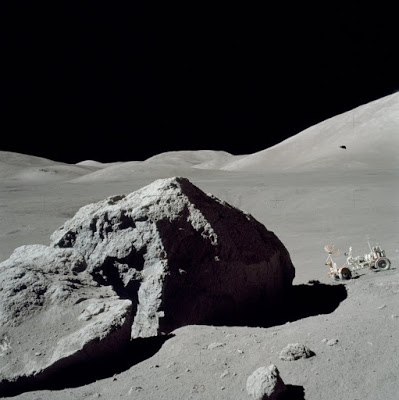
Image AS17-140-21495
The mosaic image has been photoshopped to add stars to the sky. As you can see, the original two images provided by NASA show a perfectly black sky devoid of all stars. This is typical of all of the images provided by NASA which were purported to have been taken from the lunar surface. The reason given for the absence of stars in photos taken from the surface of the moon is often attributed to the exposure setting of the astronauts’ cameras being set to daylight exposure. This explanation seems to satisfy most people, for on Earth we do not typically see stars in the sky during the daytime. People tend to impose onto the lunar expeditions the type of conditions which would exist on the Earth.
In an August 12, 1969, Apollo 11 post-flight press conference, astronaut Neil Armstrong states, “We were never able to see stars from the lunar surface or on the daylight side of the Moon by eye without looking through the optics.” Armstrong additionally affirmed that stars were visible with the naked eye only when they were in the shadow of the Moon. With these words, we see that the Apollo astronauts described identical viewing conditions of the heavens from the lunar surface as one would experience from the surface of the Earth.
At the website Ask An Astronomer, Dave Kornreich answers a daycare teacher’s question regarding why we cannot see stars shining in the sky during the daytime on Earth. At the end of his answer, Dave Kornreich, who received his PhD from Cornell University in 2001 and is now an assistant professor in the Department of Physics and Physical Science at Humboldt State University, adds an interesting tidbit of information about viewing conditions from the moon.
Q: I’m a teacher in a daycare. Each week we have a theme for are (sic) program. Last week it was the stars in the sky. This little boy asked me “why do stars glow at night and not during the day?” I didn’t know what to answer so maybe you can help me answer this question for the little boy.
A: Stars do glow during the day, but we can’t see them because of the glare of sunlight. When the sun is up, the blue color in sunlight gets scattered all over the atmosphere, turning the sky the familiar bright blue color. This blue light is much brighter than the faint light coming from the stars, so it prevents us from seeing them.
If you were standing on the Moon, for instance, where there is no atmosphere, you would see the stars both day and night.
[Source: http://bit.ly/204tM4O]
Kornreich has kept his answer simple, where a layman can understand it. As light from the sun passes through the Earth’s atmosphere it encounters atoms and molecules formed primarily from Nitrogen, Hydrogen, and Oxygen. Contact with our atmosphere causes light to be scattered in all directions. As when light passes through a prism, it is separated into various wavelengths. The shorter blue wavelengths are scattered more profusely which is why the sky looks blue during the daytime. This scattered blue light appears brighter than the faint light of the stars beyond and prevents us from seeing the stars during the daytime. In effect, it is not the brilliance of the Sun which prevents us from seeing the stars in the sky. Rather, it is the light scattering properties of the Earth’s atmosphere that causes this effect.
Since the moon does not have an atmosphere, this scattering of light does not occur. The sky would not appear blue from the moon. It would appear black while the stars and planets would appear much brighter and clearer than they do even on the darkest night on Earth. It is this obscuring effect of the Earth’s atmosphere that has led to most Earth based observatories being located at high elevations atop mountains. The densest atmosphere is at lower elevations, nearer to sea level. By rising above this densest part of the atmosphere, terrestrial astronomers are able to get views of the heavens that are far more brilliant and clear than they would be able to obtain at lower elevations.
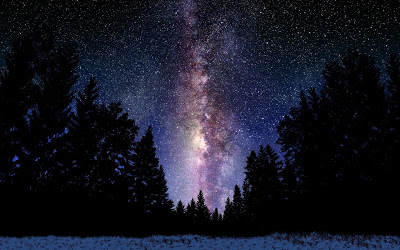
Mountain View of the Milky Way
Views of the stars from the lunar surface would far surpass the very best view from Earth. Without an atmosphere to block, absorb, or scatter light, each star would appear far more brilliant, and many more stars would be visible. Having such an unprecedented opportunity to take photographic images of the heavens from the lunar surface, one must ask why the astronauts never thought to do so. Yet even more startling is that the astronauts should say they could not see any stars in the lunar sky
On one of NASA’s own webpages, they have admitted that stars would be visible in the daytime sky from the Earth if we had no atmosphere. This would be true of astronauts standing on the surface of the moon as well. See the following link:
http://apod.nasa.gov/apod/ap070621.html
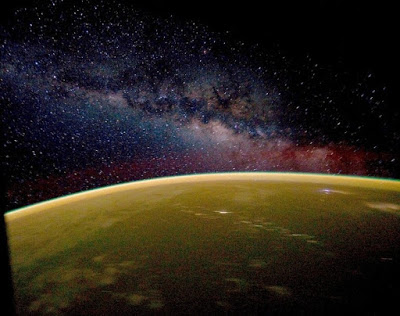
Milky Way and Earth from International Space Station
The image above was taken by an astronaut in the International Space Station with a handheld camera. With a visage like this, it is unbelievable that the Apollo astronauts remained silent about the stars they were able to see from space and from the moon, and they brought back no pictures of them. Of course, if they never actually went to the moon, the photos and accounts given by the astronauts are understandable. It would be easier to state that no stars are visible from the lunar surface during the daytime than to attempt to fake authentic images of the starry host which would be far more numerous and brilliant than what was observable from Earth.
Aside from the bad science contained in the NASA narrative of the moon missions, there is significant evidence of the moon photos having been staged on Earth, oftentimes in a studio environment with artificial lighting sources. It should not strain the sensibilities of any person to imagine NASA staging and faking shots they claim were taken on the moon. It is no secret that NASA created simulations of the lunar surface, complete with lunar modules, rovers, and the various science experiments the astronauts were to carry out. These staged conditions were ostensibly used for astronaut training. It would be a relatively simple matter to use the same, or similar props and staging, to create fake images and videos of the astronauts on the moon.
The following link is to a NASA document describing the various simulators they developed for astronaut training.
https://www.hq.nasa.gov/alsj/NASATND7112.pdf
NASA invested much effort in creating realistic looking simulations. At NASA’s Langley Research Center in Virginia, the space agency employed artists who used photographs of the lunar surface taken from satellites and telescopes, to recreate large models of the moon.
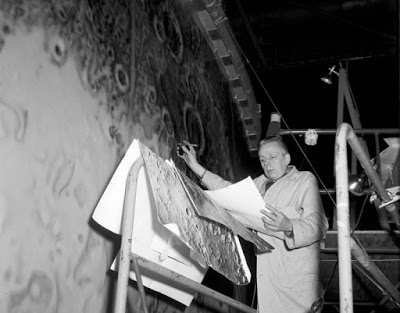
Artist Working on Moon Model at Langley Research Center
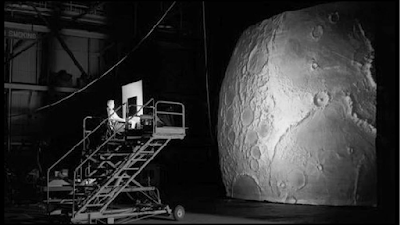
1960s Moon Landing Simulator
At NASA’s Langley Research Center they built a Lunar Excursion Module Simulator. Note that in the multiple exposure image of this simulator, it is demonstrated that by use of a giant overhead gantry, NASA was able to simulate both horizontal and vertical motion of the lunar module. It would make a perfect prop for a faked lunar landing, as well as a take-off from the moon’s surface.
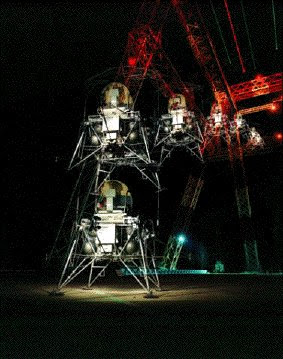
Lunar Excursion Module Simulator
Following is another image provided by NASA of their Langley facility’s lunar module simulator.

(Click on Image to View Larger)
NASA had everything they needed to make a Hollywood style production of the moon landing from right here on Earth. Interestingly, Langley, Virginia is also the headquarters for the CIA. NASA created Project LOLA – Lunar Orbit and Landing Approach, and from appearances they were creating the world’s greatest movie production stage.
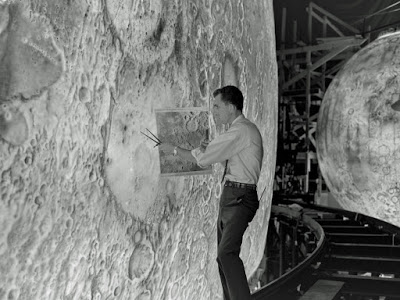
This photo from NASA’s website shows a Project LOLA engineer checking the accuracy of one of the large scale models of the moon they created. Observe the small gauge train track running along the model. Such a track would be ideal for a moving camera which would simulate the approach of the Lunar Module to the moon’s surface.
[Source: http://www.nasa.gov/centers/langley/multimedia/project-lola.html#.Vpk0avkrKUk]
NASA also created large scale terrestrial simulations of the lunar surface. Observe the image below and see if you can discern any difference from depictions of the moon.
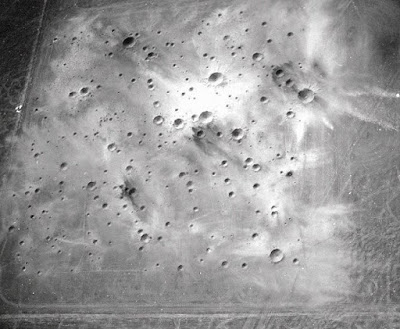
This large, multi-acre crater field is located outside Flagstaff, Arizona. It bears a striking resemblance to images of the surface of the moon broadcast during the Apollo moon missions. NASA created this crater field with dynamite and fertilizer bombs.
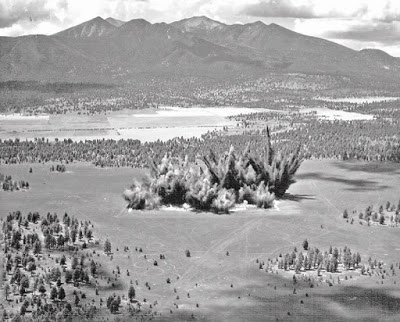
NASA Crater Field at Cinder Lake, AZ
Since NASA had built every conceivable simulation of the Apollo moon missions, and they bear a stunning similarity to the images NASA claims were taken on the moon, it is quite plausible to suggest that the entire project was faked. None of it was filmed on the moon. There are additional photographic anomalies which point to the Apollo program being a terrestrial production. These will be examined in the next chapter.
Heart4God Website: http://www.heart4god.ws
Parables Blog: www.parablesblog.blogspot.com
Mailing Address:
Joseph Herrin
P.O. Box 804
Montezuma, GA 31063


Dear Joseph, I am the unofficial designated "black-sheep" of my family. One of the many reasons my family has rejected me over the years is because I am one of those "tin-foil hat" wearing, "conspiracy kooks" and very proud of it! As a teenager I read some of my grand-father's books like "None Dare Call It A Choice" (P. Schafly) and "None Dare Call It Conspiracy" (G. Allen) and my mind opened wide to the possibility that I was being lied to on a very regular basis. The first conspiracy I first began to openly talk about as a young adult was that of the FEDERAL RESERVE BANK and the direct income tax hoax. After that the flood gates just opened wide. One of the very first revelations I received at an early age was the simple maxim, "Follow the money and you will soon find the truth." Whether, the moon-landing hoax, the JFK assassination, the Reagan assassination attempt (allegedly by the son of George H.W. Bush's best friend – while in Yale – as well as long-time business partner and major campaign contributor throughout his career), 9-11-2001, Sandy Hook, etc. ad nauseum – there is always a money trail that cannot be erased! However, the greatest conspiracy of all is the unseen one that has been going on for around six thousand years. Our enemy is made up of one third of the fallen host – who do not need to sleep or eat as far as we know – and they have been conspiring against man-kind – to destroy it. From the time of Cain, Nimrod and Esau to Mussolini, Hitler, Stalin to the Bushes, the Clintons and Obama – the devilish fallen host have always found willing pawns to exercise their evil schemes against humanity. However, all of these conspiracies to destroy man-kind will soon be defeated at the coming of our wonderful Savior and King. The enemy knows their time is short and they also know they were defeated at the cross. Their only hope is to try to thwart the rapture and the victorious return of the King by exterminating all born again believers and Jews and / or to destroy all humanity before hand. By the prophetic word of Yahweh we know that will NEVER happen! Thank you for writing this… Hopefully, a few more "good-hearted", "well-intentioned" believers will awaken and stop wasting there time, energy and financial resources on a completely meaningless Presidential election and instead redirect them to that which has eternal value and reward. Shabbat shalom! Your Friend, Robert McDuffie
It is interesting to me that NO ONE has commented on the last few chapters despite your request to hold such questions until after you've posted the entire book. That level of control in the face of one of the biggest lies in human history is staggering to me! You'll never have enough time to answer the barrage of questions that must surely come at the conclusion of this work. I must admit that this topic and the 9/11 charade make my blood boil just thinking about them. I'm hoping that one of the next chapters is entitled "PROOF" before this entire thing is consigned to that great pile of hoaxer trash available on the internet. There are equal and more plausible explanations for everything you have covered so far. That NASA is bent is beyond question, they have played a major role in disseminating the 'magic' that keeps the 'wool over our eyes'! The last few shuttle missions were pregnant with occult ritual and meaning as a means to communicate to those in the know that the 'Arab Spring' movement would usher in the next era of the 'New World Order'. I can't wait to read the next chapter! God Bless!